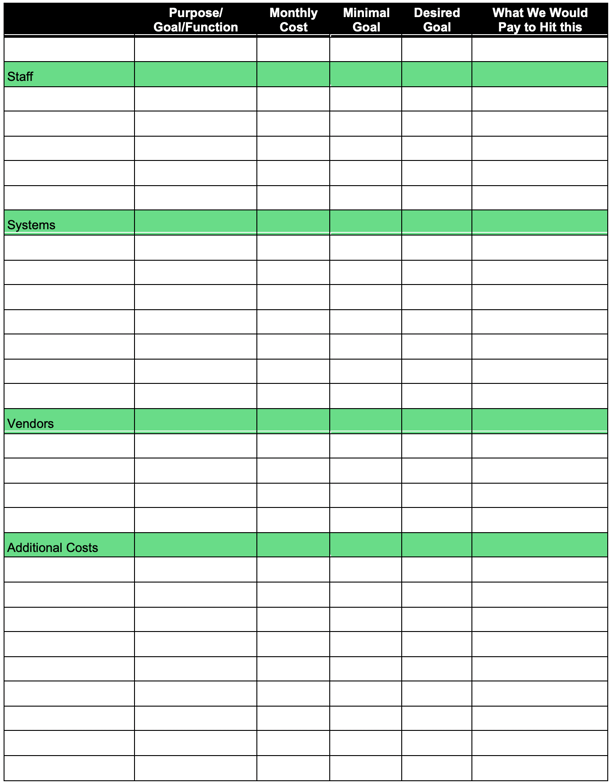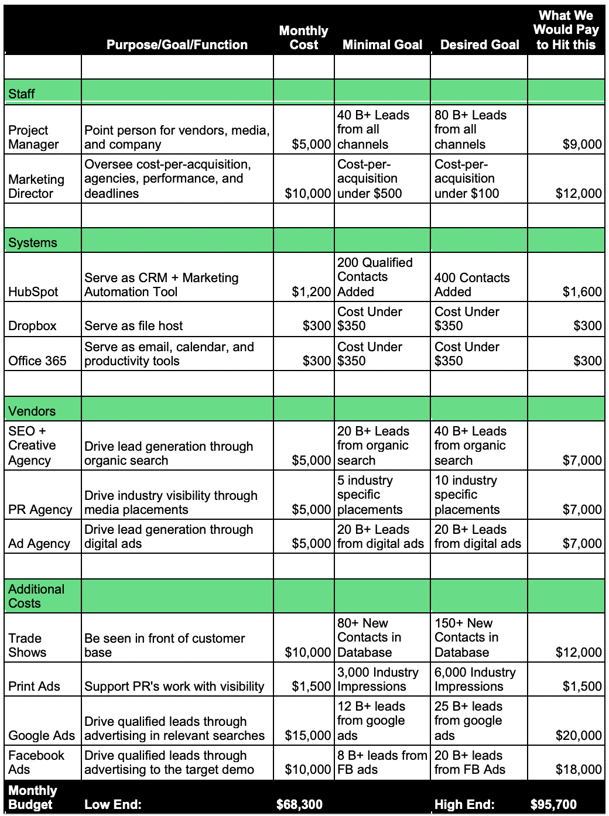How to Build the Right B2B Marketing Budget in 2021
How to Build the Right B2B Marketing Budget in 2021
For B2B companies, the most important aspect of planning your marketing for a new year is determining your budget. If you google “How much money should a company budget for marketing?” you get a variety of answers. The U.S. Small Business Administration recommends 7 to 8% of gross revenue. Legal Zoom suggests 9 to 12% of gross. And about 2.1 million marketing agencies have written blog posts that suggest a range of 10-20% of gross.
The truth is that this is more of an art than a science. There are factors within your business that you need to consider. However, we’ve developed a two-step process to help companies simplify and maximize their budget.
Step One – Perform a Budget and Resources Audit
We have our Cost-Per-Acquisition, now it’s time to audit our current spend and resources.
Take a look at the sheet below:

If you’d like a digital copy, duplicate this template and begin to fill it out accordingly.
While the sheet is pretty straightforward, let’s go through it and I’ll give you some tips and tricks to get the most out of the exercise.
(Note that if your specific operation would benefit from a segmentation that differs from Staff, Systems, Vendors, and Other, feel free to lean into what works for you.)
On the left-hand side, be as thorough as you can be. Every person in the internal growth department should be accounted for. Each system, even the ones you only pay a small sum a month for, needs to go in. Any and all vendors, need to be thrown in. And lastly, if it’s related to growth and not covered in the first three sections, it goes in the last bucket.
First, write down WHAT we’ve been spending money on in Column A. In Column B, it’s time to identify WHY we are spending this money on this person, system, agency, or additional entity. Don’t be snarky. There’s a reason why you’ve made this spend and even if it’s not working, define the intention. This is an incredibly important step because of the why is almost always correct, it’s what and how we typically need to optimize.
In Column C, add up the costs. Be as specific as you can, but don’t beat yourself up if you’re having to ballpark it. Again, your upcoming budget and plans will be outlined soon, so if you’re a little off, it’s not going to ruin the exercise.
Next up, it’s Performance Review time!
Go through each cost and rank his/her/its performance accordingly.
All done? Great. Let’s look at where we are.
-
Staff
The EOS model, inspired by the Jim Collins book From Good to Great, consistently challenges businesses to answer “do we have the right people in the right seats?” If employee performance isn’t up to par, you need to understand if the problem is the employee him or herself, or if he or she is a great asset simply working in a way in which he/she cannot be successful. If you’re going through this audit and find that an employee’s work is not successfully meeting its purpose, then chances are, a change is needed to be made. This doesn’t mean to fire the employee, but to look at the purpose/goal/function of the marketing spend and identify where a better solution could be implemented.
-
Systems
One thing businesses often find themselves in is what I call the “Netflix Upside Down” with business software and systems. With Netflix, a month goes by and $10 gets taken from your card on file. Some months, you may be watching Netflix all the time and other times, you may go 6 months without using it. But you never cancel Netflix because it’s seemingly so cheap and you know that when you do want to use it, it’s there.
This happens all the time with business software. Small subscriptions for social media publishing, SEO monitoring, email marketing, project management, and other tools get charged every month to a card and nobody even realizes it. On their own, they are small sums that waste a little money, but nothing back-breaking. However, these can add up and money that can be invested in better growth measures is currently being allocated to systems that nobody uses. Look over your list and make sure that everything you’re paying for, you actually need and use, and anything that you don’t, cut the cord with it.
If needed, pull out the monthly credit card statements and review your expenses to ensure everything is being accounted for.
-
Vendors
Vendors, especially those that you are tied to via contract, can be complicated. Similar to your staff, you need your vendors to successfully fulfill their purpose/goal/function. Unlike your employees, these vendors should be looked at as specialists and if they are not meeting your expectations, alternative replacements need to be considered.
In looking at vendors in the past, there’s a good chance that their purpose/goal/function was confined to a service. When you’re working within Purposeful Marketing, you recognize how you need their service to operate within the whole operation. Internally, this will give you the clarity to understand how to fit the right vendors into your upcoming initiatives more seamlessly.
Keep, Kill, or Improve
Let’s turn what has been discussed in purposeful change. Go through the list and identify if this spend needs to stay (keep), be eliminated altogether (kill), or you need the function of this spend, but what you are paying and what you are getting needs to be improved.
If you’re unsure of which label to put on a spend, mark it as “improve.”
Step Two – Goal Setting
It’s time to flip the Budget and Resources Audit on its head. Duplicate the sheet you filled out in Step One.
- Delete all of the columns to the right of “Monthly Cost” Delete every line item you have chosen to “Kill.” Highlight every line item you have determined to “Improve.”
- Next, add three columns to the right of Monthly Cost:
- Minimal Goal
- Desired Goal
- What We Would Pay to Hit This
- Under each section (Staff, Systems, Vendors, Additional), add 5-10 rows to consider the new activity.
Your sheet should look like this:

Look at the costs you’ve outlined. This is your low-end budget. You’ve done this before; you can live with it. You’ve decided these factors are worth keeping or need improvement, and through this, you have determined your budget floor. Congrats! Now let’s see where you can go.
- Add anything under Staff, Systems, Vendors, or Additional that you are considering this year. Write them all out. You can easily delete them if you determine them not to be the right use of funds. Identify how much these will cost (do your research and be accurate).
- Assign a minimal monthly goal to every SINGLE marketing spend you have or are considering. Every single one of them. Make sure one of those is your Cost-Per-Acquisition. Consider the purpose/role/function of each. If you have a staff member dedicated to helping you obtain leads via search, that person’s goal should be something like “20 A+ Leads via Search”. The reason you want to determine your minimal goal is that this will become a future justification for continuing to spend on this particular item.
- It’s time to aim a little higher in the sky. Consider what you really want out of this Staff member, System, Vendor or other venture. What’s the real goal? Be realistic, but aim high, and fill out the “Desired Goal” column.
- Consider what you would actually pay if you KNEW it would hit that desired goal.
- Determine which of the new budget line items you are considering will stay and which will go. If you were to include all of them, you can now take the sum of Column C and Column F and you have your low-end and high-end monthly budget. However, if those numbers are higher than you desire, you need to determine which budget items to eliminate.
You should be left with a low-end and high-end monthly budget. You know your floor, but you also know what you’ll pay to get the desired results. Let’s go through an example to simplify.
Example
Here’s a simple version of what a monthly budget may look like for a $100-$120 million-dollar company. It’s simplified, and many budgets will be far more robust than this, but the process remains the same.

Each section makes it clear why you’re spending the money, the minimum spend you’ll allow for the minimal result, and finally, what you’d be willing to spend to get the results you desire.
Conclusion
Creating a marketing budget is not easy. This method allows you to create a budget that is practical, aspirational and keeps your dollars accountable to the mission at hand.



